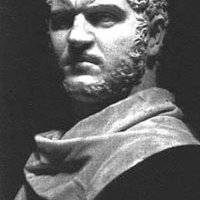
Aurelio Padilla-Monge
Aurelio Padilla-Monge nació en Sevilla el 7 de junio de 1952. Realizó sus estudios de Filosofía y Letras (Sección de Historia) en la Universidad de Sevilla, en la que obtuvo la Licenciatura en 1976. Durante su etapa de estudiante, participó en dos campañas de excavaciones arqueológicas en la ciudad romana de Carteia, dirigidas por el Prof. Dr. Francisco José Presedo Velo, en las que se gestó su posterior vinculación con el Departamento de Historia Antigua de la Universidad de Sevilla. Después de una etapa cercana a una década dedicada a la enseñanza de los más pequeños, desde su puesto de Profesor de Enseñanza General Básica, que le permitió dotarse de una sólida formación pedagógica y didáctica, volvió a vincularse a la actividad universitaria, como alumno de los Cursos de Doctorado correspondientes. En 1984 defendió la Memoria para la obtención del Grado de Licenciado, con el trabajo titulado “Colonia Asido Caesarina”, elaborado bajo la dirección del Prof. Dr. José María Santero Santurino, catedrático de la Universidad de Sevilla, por el que obtuvo la máxima calificación de sobresaliente cum laude por unanimidad. En 1986 inició su relación profesional con la Universidad de Sevilla, como Profesor en Comisión de Servicios en el Departamento de Historia Antigua. Entre 1988 y 1990, se mantuvo esta relación, primero como Profesor Titular Interino de Escuela Universitaria (1988) y después como Profesor Asociado de Universidad (1988-1990), en ambos casos en el Departamento de Historia Antigua. Durante su etapa como Profesor Asociado de Universidad, defendió en la Universidad de Sevilla la Tesis “La provincia romana de la Bética (253‑422)”, que realizó bajo la dirección del Prof. Dr. Genaro Chic García, para la obtención del grado de Doctor en Geografía e Historia (Sección de Historia), obteniendo la máxima calificación de apto cum laude por unanimidad. Tras la obtención del Grado de Doctor, ha mantenido su vinculación docente e investigadora con la Universidad de Sevilla, primero como Profesor Titular Interino de Universidad en el Departamento de Historia (1990-1993) y después como Profesor Titular de Universidad en dicho Departamento, desde 1993 hasta el día 30 de septiembre de 2018, en el que se jubiló.
Sus principales líneas investigación han sido las siguientes:
• Sociedad y economía de la Bética romana durante los siglos III-V.
• Historia del Sur de la península ibérica en época prerromana.
• Fuentes literarias.
• Poblamiento romano y ordenación territorial de la Bética romana.
• Toponimia.
• Aspectos sociales de la Bética romana.
• Élites provinciales béticas.
• Prosopografía.
• Epigrafía.
• Aspectos económicos de la Bética romana.
• Aspectos económicos del Imperio romano.
• Producción y distribución de mármoles.
Sus principales líneas investigación han sido las siguientes:
• Sociedad y economía de la Bética romana durante los siglos III-V.
• Historia del Sur de la península ibérica en época prerromana.
• Fuentes literarias.
• Poblamiento romano y ordenación territorial de la Bética romana.
• Toponimia.
• Aspectos sociales de la Bética romana.
• Élites provinciales béticas.
• Prosopografía.
• Epigrafía.
• Aspectos económicos de la Bética romana.
• Aspectos económicos del Imperio romano.
• Producción y distribución de mármoles.
less
Related Authors
Genaro Chic-García
Universidad de Sevilla
Miguel Ángel Tabales Rodríguez
Universidad de Sevilla
Salvador Ordóñez Agulla
Universidad de Sevilla
Enrique Melchor Gil
Universidad de Córdoba
Mª Ángeles Alonso-Alonso
Universidad Nacional de Educación a Distancia
José Remesal Rodríguez
University of Barcelona
Elena Castillo Ramírez
Universidad Complutense de Madrid









Uploads
Papers by Aurelio Padilla-Monge
ABSTRACT: In this Minor Thesis, I study the historical evolution of the ancient Asido, the current Medina Sidonia (province of Cadiz), from its beginning as a small village likely built in the 8th century BC, until its transformation into a Roman colony, probably in 15-14 BC. I include particular studies on a) the grant to Asido of the Latin right by César, b) the transformation of the city into a Roman colony during the reign of Augustus, c) the society of Asido, d) the economy of the city and its territory, e) the integration of the colony in the Roman administration and in the road network that the Roman Empire deployed in Baetica, f) the pre-Christian and Christian religious expressions. I also incorporate three very specific studies; the first on the name of the city, the second concerning the inscription CIL II, 1305, and the third about the historical evolution of the Asido during the 4th and 5th centuries AD, a period in which this city reached a great importance as a centre of power.
ABSTRACT: Some remarks about specific aspects of the Roman quarries located in Almadén de la Plata are made in this paper. These issues are related to: the relationships that they might have with the pagus Marmorariensis; the attempt to identify them with the Mons Mariorum cited in an ancient itinerary; the links existing between them and the statio serrariorum Augustorum testified in Italica, and the subject of the inclusion of these quarries in the Patrimonium Caesaris. Likewise, it is suggested that there was an imperial building activity in Italica in Severan times.
ABSTRACT: The main aim of this paper is to establish the nature of P. Cornelius Scipio’s relationships, if any, with the autochthonous settlement later named Italica, a link only documented by Appian’s account. I defend in this paper: a) that we can at most accept its primary and only nature of temporary lodging for wounded soldiers of Scipio’s army, b) that there are no grounds for supporting the hypothesis of the existence of a Roman foundation in Italica, and c) that the name Italica was likely imposed to the autochthonous town by the Italic people settled long afterward, rather than by Scipio.
ABSTRACT: According to Archaeology, the Greeks had more intense relationships with the Phoenician colony of Huelva than with any other town of the Southern Iberian Peninsula, during the last third of the seventh century and the first third of the sixth century B.C. Therefore, it can be sustained that the Greeks gave the name Ταρτησσός to the quoted colony, independently of how this term evolved later. The break of the direct Greek contacts with this town, during the second half of the sixth century B.C., caused that the precise location of Tartessus fell into oblivion.
ABSTRACT: The foundation of a Phoenician colony on lands of the modern city of Huelva, in the second quarter of the ninth century BC, is defended in this paper. It is also argued that the settlers of Eastern Mediterranean origin can be identified by their dwellings, places of worship, and necropoleis, among other samples of their material culture, and that the presence of settlers belonging to the local substratum is not adequately proven.
ABSTRACT: According to Archaeology, the town put up on San Antonio-Los Palacios Hill, later named Italica, had a completely autochthonous nature until the late second century B.C. The settlement of Italian immigrants in this place at that time is proved by the typology of certain buildings alien to the local forms and by the start and spread of villa system. Data allow proposing that the families of the local elite of Italica got rich probably from the production and sale of olive oil, the elaboration and export of wine and the exploitation of iron mines located in Munigua’s territory. This last one was probably the most thriving business to the local elite of Italica. On the contrary, no data allow asserting that this took part in the exploitation of the quarries of Almadén de la Plata.
ABSTRACT: Archaeological, philological and toponymic data, as well as epigraphic and literary sources disapprove of identifying the Tarshish linked in the Bible to Solomon of Israel and Hiram I of Tyre with the site named Tartessus in some Greek literary sources and with the colony founded by Phoenicians on what is now the city of Huelva, presumably around the second quarter of the ninth century B.C., be the identification of this Phoenician colony with Tartessus proposed or not. On the contrary, they recommend placing the biblical Tarshish in the Eastern Mediterranean, specifically in the country of Tarsisi quoted by an Assyrian inscription, closely bound to the city of Tarsus. The presence of another two Tarshish in the Mediterranean Levant bolsters the ties of Tarshish with this area, rather than with the Iberian Peninsula.
ABSTRACT: The aristocratic families comprising the elites in each of the communities of the Lower Guadalquivir region during the 5th-3rd centuries BCE stood at the apex of economic units having the social form known as the «great house», typical of agrarian societies ruled by warrior aristocracies. Starting in the mid-5th century BCE, some of these aristocracies began multiplying their exchanges with Gadir. Their participation in such transactions did not turn them into trading aristocracies since exporting was not only not their sole activity but probably was not even one of the most important of their sources of wealth. To the contrary, there is a good case for the growing importance of the activity carried on by private traders, largely from Gadir, who probably operated within the coordinates defined by a regulated system of trade which would still have controlled some major aspects of commercial exchange.
RESUMÉ: Les familles aristocratiques qui formaient les élites de chacune des communautés du Bas Guadalquivir pendant les V-IIIe siècles av. J.-C. étaient à la tête des unités économiques répondant à la forme sociale de la « grande maison », qui était le propre des sociétés agraires dirigées par des aristocraties guerrières. À partir de la moitié du Ve siècle av. J-.C., certaines de ces aristocraties ont multiplié leurs échanges avec Gadir. Leur participation à ces transactions ne faisait pour autant pas d’elles des aristocraties commerciales, car l’exportation n’était pas leur seule activité ; de plus, elle ne fut probablement pas l’une de leurs plus importantes voies d’enrichissement. Au contraire, on peut défendre l’idée d’une importance croissante de l’activité déployée par des commerçants privés, fondamentalement gadirites, agissant probablement à l’intérieur des coordonnées définies par un commerce administré qui devait toujours contrôler certains aspects importants des échanges.
ABSTRACT: I defend in this paper the hypothesis that the structures set up by the Phoenicians in the North of the present peninsula of Cadiz, from the late ninth century or early eighth century B.C. onward, were mainly devoted to the religious activities of the settlers established in the colony of Doña Blanca and that fish processing labours were also carried out in the ancient island of Cadiz. Likewise, I argue that these buildings became, over the course of the sixth century B.C., both an important population entity from a demographic point of view, on account of the arrival of people from the Phoenician colonies sited in the Low Guadalquivir and the area of Huelva, a territory in which the Canaanite colonial world collapsed, and an important centre from a political and economic point of view, to a great extent due to the disappearance of the quoted colonial horizon.
ABSTRACT: Several elements of the story narrated by Herodotus (I, 163) about Arganthonius, King of Tartessus, allow questioning the historical reality of this personage: first, the mythical aspects of his figure, since he can be considered both a realization of the picture of the friendly king who welcomes the travellers and an embodiment of the idea of a far-off and mysterious source of wealth; second, the chronology of his reign and his life, in which a mythical period of Mesopotamian origin was used; third, the history itself of his relationships with the Phocaean sailors, in which a narrative cliché was employed, and finally the likely origin of his own name, maybe taken by Charon of Lampsacus from a Bithynian mythological cycle.
ABSTRACT: The anthroponomastic analysis of the members of the oligarchy of Carteia proves the existence of most descendants from the Hispano-Roman people to whom Livy (43.3.2) refers, or from incomers who arrived later from Italy. Nevertheless, this analysis also shows the presence of some descendants from the inhabitants of Punic Carteia who choose to live in the new Latin colony (Livy, 43.3.4).
ABSTRACT: Aurelius Iulius, Aurelius Ursinus, Calpurnius Salvianus, P. Coelius Apollinaris, P. Coelius Balbinus Vibullius Pius, P. Coelius Apollinaris, Ser. Iulius Servianus, L. Licinius Squillus y M. Rutilius Cosinius C[alv]us/G[all]us, individuals who have been related to Italica and sometimes considered natives of this Baetican town, although the known data do not allow to prove this origin, are examined in this paper.
ABSTRACT: Anthroponymy suggests the existence, in the oligarchy of Gades (modern Cadiz), of individuals belonging to three groups from several origins, i.e., the Phoenician and Punic demographic base, pre-Phoenician inhabitants, and immigrants, mainly Italians.
ABSTRACT: The onomastic evidences prove the integration of native individuals and Italic immigrants or their descendants in the local oligarchy of Baelo, but they do not document the incorporation of individuals coming from the prerroman Bailo, or their descendants, with personal names confirming the Punic cultural influences that numismatic data seem to attest.
ABSTRACT: Beginning with the turning of Cadiz in a Roman city and the implication of the enriched oligarchy by the fishing-canning and commercial activities, I analyze the consequences in the Bay of Cadiz of the acquisitions of big properties by great equites and senators from Cadiz with the purpose, on the one hand, of investing their richness and, on the other hand, assuming the mentality of aristocracy landowner ruling during the Empire, of maintaining without a spot the status of the nobilitas. The deurbanization of Gades, in Avienus’ times, is the aspect that I turn as a reference to analyze the relocation of the insular population in continental lands.
ABSTRACT: In this paper, I show that a more accurate interpretation of the Bible, Assyrian epigraphic sources and archaeological data, added to new discoveries, allow us to confirm the correspondence between the biblical Tarshish and the Tarsisi country cited by the Assyrian epigraphy. Hence traditional attempts to locate Tarshish in the Southwest of the Iberian peninsula and its identification with Tartessos must be given up.
ABSTRACT: In this paper, I defend that the controls inscribed during the reigns of Domitian, Trajan and Hadrian on blocks and columns found in the imperial quarries of Dokimeion, in Phrygia, and on pieces cut free in these quarries but found in Ostia-Rome, seem to involve its exploitation both directly by the State and by private contractors (conductores or redemptores), in some cases simultaneously.
ABSTRACT: I defend in this paper that the controls inscribed on blocks and columns found in the Imperial quarries of Dokimeion, and on pieces cut free in these quarries but found out of Phrygia, seem to evidence the predominance, between A.D. 136 and 236, of the direct exploitation system in which imperial agents controlled the work of technicians, who were in some cases members of the State bodies and in other ones contracted skilled men.
ABSTRACT: I set out in this writing some observations about the formation and development of “Patrimonium Caesaris” regarding the quarries and some assessments in relation to the legislation on the private quarry exploitation. Likewise, I analyse some aspects of the distribution of the Imperial production and the degree of private participation in the marble trade.
ABSTRACT: In this paper, I study the historical evolution of Imperial quarries during the third, fourth and fifth centuries. I connect the reduction of output with large stocks of marble (the result of the high level of production kept up for two centuries) and the fall of marble consumption. This situation led to an Imperial policy, developed in the fourth century, to make the most of the Imperial quarries (the profits of which came into the “Aerarium Sacrum”). This policy promoted the consumption of Imperial stones by: a) the opening-up of the quarries to the private sector, b) the enactment of legislation aimed at stopping the re-use of marble taken from ancient structures and deserted towns, c) the increase of the obligations imposed on the private quarry operators and, finally, d) the prohibition of working private quarries in order to divert private business to the Imperial ones.
ABSTRACT: In this Minor Thesis, I study the historical evolution of the ancient Asido, the current Medina Sidonia (province of Cadiz), from its beginning as a small village likely built in the 8th century BC, until its transformation into a Roman colony, probably in 15-14 BC. I include particular studies on a) the grant to Asido of the Latin right by César, b) the transformation of the city into a Roman colony during the reign of Augustus, c) the society of Asido, d) the economy of the city and its territory, e) the integration of the colony in the Roman administration and in the road network that the Roman Empire deployed in Baetica, f) the pre-Christian and Christian religious expressions. I also incorporate three very specific studies; the first on the name of the city, the second concerning the inscription CIL II, 1305, and the third about the historical evolution of the Asido during the 4th and 5th centuries AD, a period in which this city reached a great importance as a centre of power.
ABSTRACT: Some remarks about specific aspects of the Roman quarries located in Almadén de la Plata are made in this paper. These issues are related to: the relationships that they might have with the pagus Marmorariensis; the attempt to identify them with the Mons Mariorum cited in an ancient itinerary; the links existing between them and the statio serrariorum Augustorum testified in Italica, and the subject of the inclusion of these quarries in the Patrimonium Caesaris. Likewise, it is suggested that there was an imperial building activity in Italica in Severan times.
ABSTRACT: The main aim of this paper is to establish the nature of P. Cornelius Scipio’s relationships, if any, with the autochthonous settlement later named Italica, a link only documented by Appian’s account. I defend in this paper: a) that we can at most accept its primary and only nature of temporary lodging for wounded soldiers of Scipio’s army, b) that there are no grounds for supporting the hypothesis of the existence of a Roman foundation in Italica, and c) that the name Italica was likely imposed to the autochthonous town by the Italic people settled long afterward, rather than by Scipio.
ABSTRACT: According to Archaeology, the Greeks had more intense relationships with the Phoenician colony of Huelva than with any other town of the Southern Iberian Peninsula, during the last third of the seventh century and the first third of the sixth century B.C. Therefore, it can be sustained that the Greeks gave the name Ταρτησσός to the quoted colony, independently of how this term evolved later. The break of the direct Greek contacts with this town, during the second half of the sixth century B.C., caused that the precise location of Tartessus fell into oblivion.
ABSTRACT: The foundation of a Phoenician colony on lands of the modern city of Huelva, in the second quarter of the ninth century BC, is defended in this paper. It is also argued that the settlers of Eastern Mediterranean origin can be identified by their dwellings, places of worship, and necropoleis, among other samples of their material culture, and that the presence of settlers belonging to the local substratum is not adequately proven.
ABSTRACT: According to Archaeology, the town put up on San Antonio-Los Palacios Hill, later named Italica, had a completely autochthonous nature until the late second century B.C. The settlement of Italian immigrants in this place at that time is proved by the typology of certain buildings alien to the local forms and by the start and spread of villa system. Data allow proposing that the families of the local elite of Italica got rich probably from the production and sale of olive oil, the elaboration and export of wine and the exploitation of iron mines located in Munigua’s territory. This last one was probably the most thriving business to the local elite of Italica. On the contrary, no data allow asserting that this took part in the exploitation of the quarries of Almadén de la Plata.
ABSTRACT: Archaeological, philological and toponymic data, as well as epigraphic and literary sources disapprove of identifying the Tarshish linked in the Bible to Solomon of Israel and Hiram I of Tyre with the site named Tartessus in some Greek literary sources and with the colony founded by Phoenicians on what is now the city of Huelva, presumably around the second quarter of the ninth century B.C., be the identification of this Phoenician colony with Tartessus proposed or not. On the contrary, they recommend placing the biblical Tarshish in the Eastern Mediterranean, specifically in the country of Tarsisi quoted by an Assyrian inscription, closely bound to the city of Tarsus. The presence of another two Tarshish in the Mediterranean Levant bolsters the ties of Tarshish with this area, rather than with the Iberian Peninsula.
ABSTRACT: The aristocratic families comprising the elites in each of the communities of the Lower Guadalquivir region during the 5th-3rd centuries BCE stood at the apex of economic units having the social form known as the «great house», typical of agrarian societies ruled by warrior aristocracies. Starting in the mid-5th century BCE, some of these aristocracies began multiplying their exchanges with Gadir. Their participation in such transactions did not turn them into trading aristocracies since exporting was not only not their sole activity but probably was not even one of the most important of their sources of wealth. To the contrary, there is a good case for the growing importance of the activity carried on by private traders, largely from Gadir, who probably operated within the coordinates defined by a regulated system of trade which would still have controlled some major aspects of commercial exchange.
RESUMÉ: Les familles aristocratiques qui formaient les élites de chacune des communautés du Bas Guadalquivir pendant les V-IIIe siècles av. J.-C. étaient à la tête des unités économiques répondant à la forme sociale de la « grande maison », qui était le propre des sociétés agraires dirigées par des aristocraties guerrières. À partir de la moitié du Ve siècle av. J-.C., certaines de ces aristocraties ont multiplié leurs échanges avec Gadir. Leur participation à ces transactions ne faisait pour autant pas d’elles des aristocraties commerciales, car l’exportation n’était pas leur seule activité ; de plus, elle ne fut probablement pas l’une de leurs plus importantes voies d’enrichissement. Au contraire, on peut défendre l’idée d’une importance croissante de l’activité déployée par des commerçants privés, fondamentalement gadirites, agissant probablement à l’intérieur des coordonnées définies par un commerce administré qui devait toujours contrôler certains aspects importants des échanges.
ABSTRACT: I defend in this paper the hypothesis that the structures set up by the Phoenicians in the North of the present peninsula of Cadiz, from the late ninth century or early eighth century B.C. onward, were mainly devoted to the religious activities of the settlers established in the colony of Doña Blanca and that fish processing labours were also carried out in the ancient island of Cadiz. Likewise, I argue that these buildings became, over the course of the sixth century B.C., both an important population entity from a demographic point of view, on account of the arrival of people from the Phoenician colonies sited in the Low Guadalquivir and the area of Huelva, a territory in which the Canaanite colonial world collapsed, and an important centre from a political and economic point of view, to a great extent due to the disappearance of the quoted colonial horizon.
ABSTRACT: Several elements of the story narrated by Herodotus (I, 163) about Arganthonius, King of Tartessus, allow questioning the historical reality of this personage: first, the mythical aspects of his figure, since he can be considered both a realization of the picture of the friendly king who welcomes the travellers and an embodiment of the idea of a far-off and mysterious source of wealth; second, the chronology of his reign and his life, in which a mythical period of Mesopotamian origin was used; third, the history itself of his relationships with the Phocaean sailors, in which a narrative cliché was employed, and finally the likely origin of his own name, maybe taken by Charon of Lampsacus from a Bithynian mythological cycle.
ABSTRACT: The anthroponomastic analysis of the members of the oligarchy of Carteia proves the existence of most descendants from the Hispano-Roman people to whom Livy (43.3.2) refers, or from incomers who arrived later from Italy. Nevertheless, this analysis also shows the presence of some descendants from the inhabitants of Punic Carteia who choose to live in the new Latin colony (Livy, 43.3.4).
ABSTRACT: Aurelius Iulius, Aurelius Ursinus, Calpurnius Salvianus, P. Coelius Apollinaris, P. Coelius Balbinus Vibullius Pius, P. Coelius Apollinaris, Ser. Iulius Servianus, L. Licinius Squillus y M. Rutilius Cosinius C[alv]us/G[all]us, individuals who have been related to Italica and sometimes considered natives of this Baetican town, although the known data do not allow to prove this origin, are examined in this paper.
ABSTRACT: Anthroponymy suggests the existence, in the oligarchy of Gades (modern Cadiz), of individuals belonging to three groups from several origins, i.e., the Phoenician and Punic demographic base, pre-Phoenician inhabitants, and immigrants, mainly Italians.
ABSTRACT: The onomastic evidences prove the integration of native individuals and Italic immigrants or their descendants in the local oligarchy of Baelo, but they do not document the incorporation of individuals coming from the prerroman Bailo, or their descendants, with personal names confirming the Punic cultural influences that numismatic data seem to attest.
ABSTRACT: Beginning with the turning of Cadiz in a Roman city and the implication of the enriched oligarchy by the fishing-canning and commercial activities, I analyze the consequences in the Bay of Cadiz of the acquisitions of big properties by great equites and senators from Cadiz with the purpose, on the one hand, of investing their richness and, on the other hand, assuming the mentality of aristocracy landowner ruling during the Empire, of maintaining without a spot the status of the nobilitas. The deurbanization of Gades, in Avienus’ times, is the aspect that I turn as a reference to analyze the relocation of the insular population in continental lands.
ABSTRACT: In this paper, I show that a more accurate interpretation of the Bible, Assyrian epigraphic sources and archaeological data, added to new discoveries, allow us to confirm the correspondence between the biblical Tarshish and the Tarsisi country cited by the Assyrian epigraphy. Hence traditional attempts to locate Tarshish in the Southwest of the Iberian peninsula and its identification with Tartessos must be given up.
ABSTRACT: In this paper, I defend that the controls inscribed during the reigns of Domitian, Trajan and Hadrian on blocks and columns found in the imperial quarries of Dokimeion, in Phrygia, and on pieces cut free in these quarries but found in Ostia-Rome, seem to involve its exploitation both directly by the State and by private contractors (conductores or redemptores), in some cases simultaneously.
ABSTRACT: I defend in this paper that the controls inscribed on blocks and columns found in the Imperial quarries of Dokimeion, and on pieces cut free in these quarries but found out of Phrygia, seem to evidence the predominance, between A.D. 136 and 236, of the direct exploitation system in which imperial agents controlled the work of technicians, who were in some cases members of the State bodies and in other ones contracted skilled men.
ABSTRACT: I set out in this writing some observations about the formation and development of “Patrimonium Caesaris” regarding the quarries and some assessments in relation to the legislation on the private quarry exploitation. Likewise, I analyse some aspects of the distribution of the Imperial production and the degree of private participation in the marble trade.
ABSTRACT: In this paper, I study the historical evolution of Imperial quarries during the third, fourth and fifth centuries. I connect the reduction of output with large stocks of marble (the result of the high level of production kept up for two centuries) and the fall of marble consumption. This situation led to an Imperial policy, developed in the fourth century, to make the most of the Imperial quarries (the profits of which came into the “Aerarium Sacrum”). This policy promoted the consumption of Imperial stones by: a) the opening-up of the quarries to the private sector, b) the enactment of legislation aimed at stopping the re-use of marble taken from ancient structures and deserted towns, c) the increase of the obligations imposed on the private quarry operators and, finally, d) the prohibition of working private quarries in order to divert private business to the Imperial ones.
RESUMEN: El reinado de Hadriano se desarrolló en una situación económica caracterizada por un marcado desajuste entre las crecientes necesidades del sistema político en desarrollo, tendente a la monarquía absolutista, y el producto social global. Hadriano optó por una política de no expansión territorial, de control riguroso de la recaudación fiscal, de multiplicación de las construcciones imperiales y de
intervención en la producción agrícola y minera y en la distribución de los géneros de interés para el Estado. Esta política tuvo grandes consecuencias en el sur de Hispania.
ABSTRACT: This is the first complete study of the history of the Roman province of Baetica during the last stage in which it was part of the Roman Empire (253-422). I use all available tools of historical analysis, with the systematic use of literary, epigraphic, legal, archaeological, papyrological, toponymic, numismatic and anthroponymic sources, to reconstruct the economic, social, administrative and mental evolution of this Roman province. I analyze the endogenous factors, which show a different evolution from what we can testify of the Western Roman Empire, and the exogenous, derived largely from the integration of Baetica in a Roman state harassed by the acceleration of a structural crisis that was the result of the imbalance between the increase in state spending and the slow and inadequate development of domestic production, since the second half of the second century.
ABSTRACT: This study proves that the Roman presence did not imply essential changes in the zone with regard to town and country planning and territory exploitation, during at least a century and a half. Finally, the Caesar and Augustus’ colonisation gave way to the real Romanization of the territory, with the definitive transformation of its economic and social structures.
ABASTRACT: I wrote this book in collaboration with V. Durán-Recio, who developed the archaeological work, the cataloging of the archaeological material and the evaluation of most archaeological sites. I am the author of the “Initial Considerations”, the “Conclusions” corresponding to each of the chapters and some precisions about several archaeological sites. This book includes a substantial number of novelties that have allowed me to carry out novel contributions and confirm hypothesis of other scholars. In short, the result of this collaboration between V. Durán and me is the integration of a territory of almost 1000 square kilometres in the historical evolution of the Southern Iberian Peninsula from Chalcolithic to the fifth century, by means of the data supplied by the territory of Écija (province of Seville) and not through the application to this territory of conclusions derived from general studies.
ABSTRACT: The study of funerary epigraphy from Baelo allows to identify individuals who were born and lived free (ingenui), others who were forced to live in slavery all their lives (servi) and others who could escape from their destiny and improve their social situation (liberti). It is sometimes possible to identify among the free people both individuals belonging to the local elite as well as those who were not rich or powerful and that could sometimes have worse living conditions than some slaves and freedmen from rich and powerful families. Likewise, funerary epigraphy identifies individuals arrived from the Italian peninsula and/or their descendants and people belonging to an important demographic base of North African origins, especially from Mauritania Tingitana, who arrived in Baelo for various reasons, especially linked to the fishing and salting activities developed in Baelo’s coast. The data also allow to defend that the establishment of North Africans in Baelo was very important, even though it depended on the private initiative.
ABSTRACT: The main target of this work is to contribute to the evaluation of the level of indigenous participation in the setting up of the elites in the Roman colonies founded in Hispania Ulterior Baetica. With this aim, I focus my attention on the identification of the autochthonous individuals from the Iberian Peninsula (Hispani) and of those who arrived from Italy and their descendants (Hispanienses), mainly by means of the name analysis. The result is the documentation of several levels of integration in each case, according to the different historical evolutions followed by each one of these communities before its transformation into Roman colonies.
ABSTRACT: I analyse in this paper the consequences in the Bay of Cadiz of the acquisitions of big properties by the new knights and senators from Gades (an oligarchy enriched by the fishing-canning and commercial activities), with the purpose of investing their richness and mainly of maintaining stainless the status of the nobilitas, assuming in this way the mentality of landowner aristocracy that ruled the Empire. Likewise I analyse the relocation of the insular population in continental land, during the Late Roman Empire, starting from the depopulation of Gades in the times of Rufus Festus Avienus.
ABSTRACT: In this text, I present an overview of outgoing and incoming goods in Malaga and its situation within the network of land, river and sea routes from a detailed analysis of archaeological and literary sources. I also emphasize the singular importance achieved by the Malaga coast in the output of Spanish salted fish and salted fish sauces during the fourth and fifth centuries. To this end, I use a conceptual framework that underlines the private trade dependence of the distribution channels arranged by the Roman State in accordance with its own needs and stresses the predominance of traders working for the local oligarchies to ensure the city supply.
ABSTRACT: In this paper I propose that the prevalence of the Ancient mentality in the Late Roman Empire had a prejudicial influence on mining and the production of metal, because such mentality impeded the technological progress. The technical underdevelopment of the mining and metal-producing workings blocked the structure of a monetary system in accordance with the predominant mentality (no doubt, the failure of a highly fiduciary monetary system was a result of the lack of collective faith) and the increasing monetary needs of the Imperial political system.